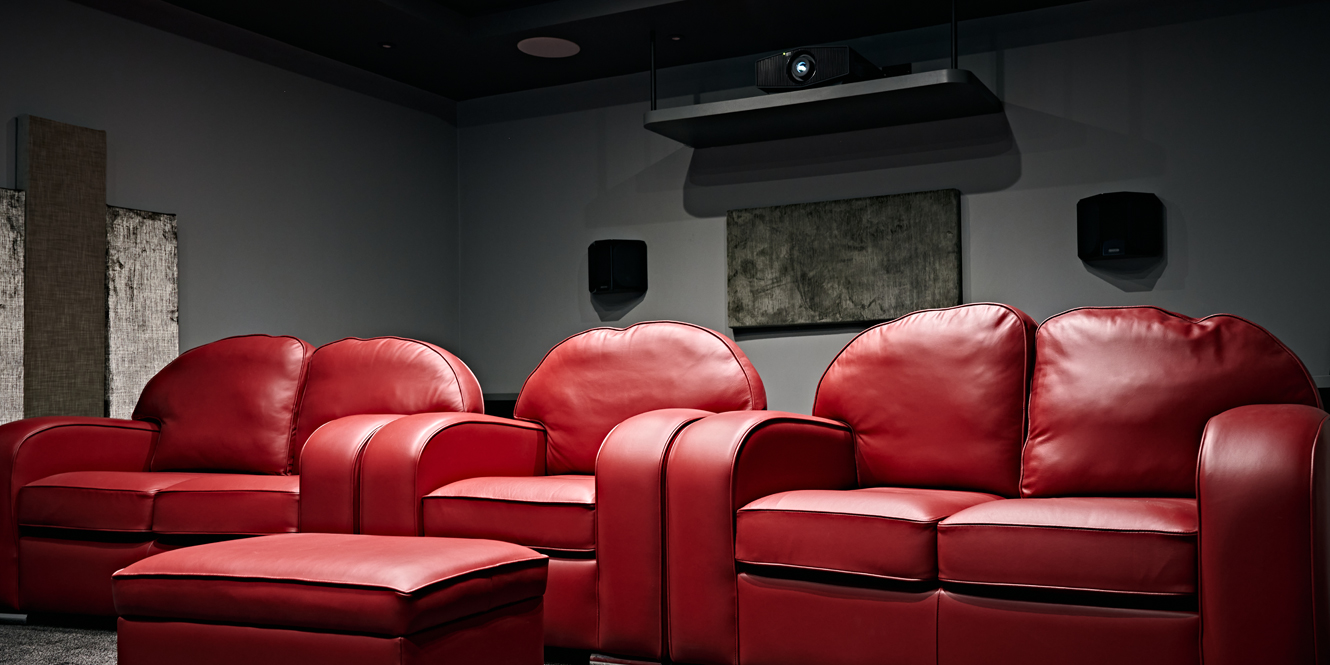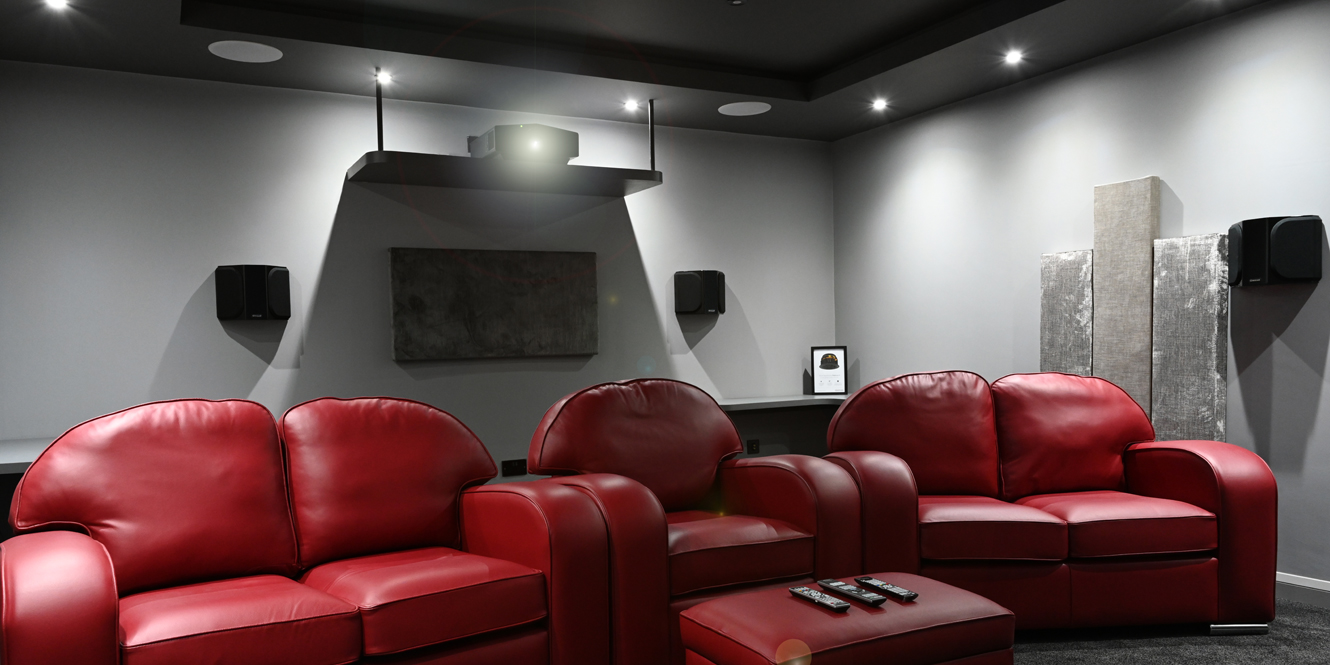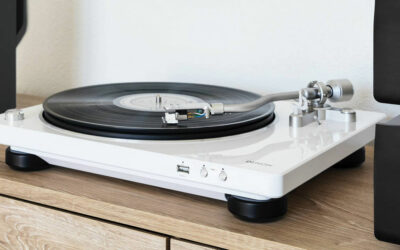So, you have a spare room and are wondering if it’ll feasibly transform into a dream home cinema. You’re going to need some cinema room ideas to inspire and guide you through the process.
I’ve made this guide to help you visualise the journey of transforming a regular room into a home cinema. In it, you’ll find four simple steps to choosing and preparing the room itself as well as what to consider when picking out AV gadgets and gear. I’ll walk you through what to account for before buying AVRs, speakers, soundbars, projectors/TVs, and Blu-ray players.
But first, if you’re in a rush, here’s a summary table to refer to when buying AV gear for a home cinema room.
At a Glance…
| Product | Key Considerations | Our Recommendation |
|---|---|---|
| TVs | Size, screen resolution, backlighting | LG OLED65B36LA 65" OLED 4K HDR Smart TV |
| Projectors | Lifespan, lumen-level, throw distance | Optoma UHD55 Projector, HDMI Cable & Spitfire 100" Screen Package |
| AVRs | Number of channels, number of inputs/outputs, HDR compatibility | Denon AVC-X3800H AV Receiver, Black with Free HDMI Cables |
| Speakers | How many, height channels, power handling, impedance | 5.1.4 System Configurator - Premium |
| Soundbars | Soundbar vs centre channel speaker, number of inputs/outputs | Sennheiser AMBEO Max Soundbar with Free HDMI Cable |
| Blu-ray player | Do you use DVDs?, quality, upscaling, smart features | Panasonic DP-UB820EB Premium UHD Blu-ray Player |
Cinema Room Ideas – Steps to Creating the Perfect Space
I know your favourite part of the home cinema room transformation will likely be the selection of shiny new tech, but hang fire. First you’re going to need a space worthy of all that gear. Do not dismiss this step! A proper cinematic environment will give your AV gear a stage on which it can reach its full potential. Here are four simple steps to creating the ideal cinema room.
Choose Your Room
The first step in the home cinema room journey is the selection of a suitable space. A basement or loft is typically recommended for the job because it gets minimal exposure to natural light. Keeping control over the lighting in your chosen environment is crucial for optimal on-screen brightness and contrast. The absence of windows or their limited presence ensures that distractions are kept at bay, allowing for greater immersion in the cinematic experience.
Make it Nice and Dark
Next, it’s time to make your chosen room even darker. This can be done by painting the walls black, a colour known for its ability to absorb light and reduce reflections. If windows are present, it is recommended that blackout curtains be installed. These curtains will completely block out any external light, ensuring the cinema room stays dark even during daylight hours.
Fill the Room with Soft Furnishings
Decorating the room with soft furnishings like plush carpets and comfortable sofas is the next stage in the journey to a cosy home cinema room. Not only will these furnishings add to the aesthetic appeal of your room but they’ll also serve practical purposes. Sound waves tend to bounce off hard surfaces such as walls or floors, causing echoes and distortion. Soft furnishings are known to act as sound buffers, absorbing rather than reflecting sounds.
As a result of adding in soft flooring, comfy furniture, and even acoustic wall panelling, fewer sound waves will bounce around the room. By creating this inhospitable environment for echoes, you can expect a much clearer sound quality that mimics the acoustics of a real cinema.
Set the Mood
Lastly, you don’t want to be constantly fumbling around in complete darkness, so now’s the time to introduce low ambient lighting back into the space. While the room should be dark for optimal viewing, some level of ambient lighting is necessary for safety and comfort. Therefore, adding dimmable, easy-to-control lighting will allow you to keep lighting levels low and adjust them whenever you need.

Now Comes the Tech
Yes! Now it’s time to be let loose in the toy store, so to speak. While there’s no harm in adding everything to your trolley, these are the things you should be aiming to prioritise.
Projectors and TVs
For a home cinema to be a home cinema you’ll need either a TV or projector to display content. The decision between a TV and a projector will be influenced by room size, lighting conditions, and personal user experience preferences. In large rooms, where a more immersive, theatre-like experience is desired, projectors might be the preferred choice. However, under conditions with unavoidable ambient light, a TV might offer better visibility.
Viewing habits
The intended viewing habits and content preferences should also be considered. For example, for regular day-to-day viewing, a TV might be more familiar and easier to control. If you prefer analogue controls, such as those of a traditional lamp projector, or will use the cinema room only for the occasional movie night, a projector might be more impressive.
Size and budget
Keep your budget in mind from the outset. If you know the size of the TV or projector screen you need, it’s a good idea to browse prices with the ‘Screen Size’ filter rather than any special technological features. In a range of NEO QLED 8K TVs for example, a 55-inch model might be within budget, but the 85-inch model you might need to fill a large space will cost much more. Choose your budget and minimum size requirement and see what’s available in your price range.
With projectors, you’re more likely to find something to suit large rooms but remember you will need to purchase the projector and a suitable screen. Make sure you factor the screen into your cost calculations as large sizes can be as expensive as some new TVs.
Shop now | Projector and Screen Packages
Selecting a model
After establishing your viewing habits, budget, and desired screen size, it’s a matter of selecting the model type. For TVs, this means considering things like display technology, resolution, HDR, and backlighting.
With projectors, you’ll want to weigh up the pros and cons of lamp vs. laser projectors as well as the throw distance, i.e., long throw, short throw, or ultra short throw. With both TVs and projectors, you’ll also need to decide on the appropriate screen size for your space.
Audio/Video Receivers (AVRs)
Next, you’ll need an Audio/Video Receiver (AVR), i.e., the heart of a home cinema. The AVR will serve as the hub for all the devices you connect, ensuring all signals are received, processed, and delivered to the appropriate location in the room with plenty of power and quality. When selecting an AVR you’ll need to consider the following:
How many channels?
The number of channels you need from your AVR will depend on how many speakers you intend to connect. For example, a 5.1.2 home cinema consists of speaker channels, meaning you’ll need an AVR with at least this many channels.
Connectivity
You’ll also need an AVR with input and output ports for all the devices you intend to connect. For example, you may wish to connect a Blu-ray player, gaming console, computer, streaming device (like an Amazon Fire Stick), and more via HDMI. Therefore, you’ll need sufficient inputs to accommodate these and save you from swapping hard-to-reach cables every time you watch something.
Compatibility
Check the compatibility of AVRs with various audio and HDR formats before you buy. The HDR format support in an AVR is often a function of the HDMI version it supports. Therefore, it is essential to verify the HDMI version of the AVR and whether it is compatible with HDR formats like HDR10, HDR10+, HLG, and Dolby Vision.
For specific details about audio compatibility, including Dolby Atmos, the support page or manual of the AVR can be a useful resource. This can be found online on each AV.com product listing or on the supplier’s website.
If you’re using a 4K or HDR TV, you must also be sure to purchase HDMI 2.0 compatible cables. These should be used between the shield and the AVR, and between the AVR and the display.
Soundbars
Depending on how many channels and speakers you want, you may need to add a soundbar to your shopping list. Soundbars and centre channel speakers are both designed to be placed in the front and centre of a home cinema. However, while a soundbar is often placed independently, a centre speaker is typically part of a larger surround sound setup. Therefore, if you’re opting for simplicity and looking to save space, consider a soundbar.
Soundbars are typically designed with an all-in-one approach, where multiple speakers are housed within a single unit. This design allows for a clutter-free setup and is often easier to install. In addition, soundbars often come with built-in amplification, eliminating the need for a separate receiver or amplifier.
However, the audio quality and surround sound effects provided by a soundbar may not always match the immersive and high-fidelity capabilities offered by separate speakers. If you do opt for a soundbar, make sure it has all the input and output ports you will need for connecting devices. Also, decide whether you’ll need to mount it on the wall or on a cabinet to achieve the optimal listening height.
Blu-ray Players
Unless you’re going to exclusively stream digital content from platforms such as Netflix, Amazon Prime Video, etc., you should think about setting up a Blu-ray player. While streaming has become an increasingly popular media, many of us still value the high-quality video offered by Blu-ray disks.
You may already have an extensive collection, in which case, it’d be a shame to let that go to waste. If you don’t have a Blu-ray player already, you’ll want to make sure you find one that’s compatible with your other equipment. Look out for the quality it offers too; HD (1080p) output is standard among Blu-ray players but for the best quality, you’ll want 4K Ultra HD.
You may also want the ability to upscale regular DVDs to a higher quality or access the internet for smart streaming. In this case, check out Blu-ray players with upscaling capability and smart features.
Speakers
The last major piece of kit needed for an awesome home cinema room is the speaker system. This can comprise several speakers but don’t worry, you can easily purchase curated bundles or configure your own bespoke system online.
You should decide how many speaker channels you’ll need by judging the size of your cinema room. In a smaller room, a basic 2.1-channel system (two speakers and one subwoofer) might suffice, while larger rooms may benefit from a more immersive 5.1- or 7.1-channel system.
The type of content that is predominantly viewed can also guide this decision. For instance, if the majority of viewing time is spent on action films or playing video games, a surround sound system would be beneficial for the full auditory experience. For the full three-dimensional Dolby Atmos experience, I advise you to look at adding height channels. These will allow overhead sounds to be distributed accurately throughout the room.
On a more technical level, you’ll need to account for things like power handling and impedance when selecting speakers. Don’t select a speaker with a maximum power rating lower than the amplifier’s output as this could lead to the speakers being damaged. You also shouldn’t select an amplifier that isn’t powerful enough to drive the speakers.
Impedance also plays a significant role. The impedance of the speakers should match the impedance rating of the amplifier. If there is a mismatch in impedance, the sound quality may be compromised or the equipment could be damaged.

FAQs
How do I make my bedroom feel like a cinema?
You can easily make your bedroom feel more like a cinema in a few steps. Start by adding black-out blinds to any areas of ambient light, then get yourself a projector or large TV. You could also place speakers around the room to mimic the surround sound effects of a cinema. For finishing touches, consider some mood lighting like wall sconces or LED strips along the skirting boards.
What is the best colour for a home cinema room?
The best colour for a home cinema room is something dark like black, navy blue, indigo, or burgundy. The darker the better as these kinds of colours will reduce distracting light reflections. If you add acoustic panels to the walls for sound absorption, make sure to select a dark colour for these as well.
How do you make a good cinema room?
Making a good cinema room will involve the following:
- Choose a room with low ambient lighting
- Make it nice and dark with black out blinds and dark paint
- Fill the room with soft furnishings to reduce echoes and distortion
- Create a cinematic ambience with some low mood lighting
- Pick out and place your TV/projector, AVR, Blu-ray player, soundbar, and speakers
- Choose a movie and dish out some popcorn
Final Thoughts
Hopefully these cinema room ideas have inspired you to get started with a transformation of your own. The hardest part of the process, in my opinion, is deciding which AV gear to get. There are so many beautiful-looking speakers and screens on the market today that they certainly don’t make our decisions simple.
If you’ve still got questions, why not stop by the AV.com showroom in Bacup, Lancashire for advice and the chance to test out AV gadgets in person?





0 Comments